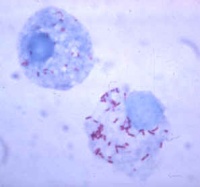Anaplasmas
| Anaplasma spp | |
|---|---|
| Kingdom | Monera |
| Sub-kingdom | Bacteria |
| Phylum | Proteobacteria |
| Order | Rickettsiales |
| Family | Ehrlichiaceae |
| Genus | Anaplasma |
| Species | Anaplasma marginale and others |
Introduction
Anaplasma species are rickettsial bacterial pathogens that reside within host erythrocytes.
Anaplasmas cause Anaplasmosis and have worldwide distribution due to their wide range of vectors. Disease is most common in tropical regions.
Lifecycle
Anaplasmas are transmitted by a wide range of tick species and other insects including the Culicoides midge and other biting flies.
Maturation can occur only in tick hosts, flies acting as solely mechanical vectors.
Infectious bacteria reside and replicate within the salivary gland of the vector and are transmitted to mammalian hosts during bloodfeeding.
Infected erythrocytes are disrupted and release bodies which can then invade other erythrocytes. These bodies form vacuoles within the cytoplasmic membranes of the red blood cells and then undergo binary fission to form dense blue-purple round/cube shaped inclusion bodies.
This amplifies infection within the host and increases the likelihood of transmission when insects bloodfeed.
For more information on ticks as disease vectors, se Tick Disease Transmission.
Pathogenesis
Anaplasmosis causes haemolytic anaemia by damaging erythrocytes.
Diseases
Anaplasmosis in domestic and wild ruminants and deer causes profound anaemia, emaciation, haematuria and consequent respiratory and neurological signs.
Anaplasma marginale
Most (70-80%) inclusion bodies are found at or close to the border of the erythrocyte. Infects cattle causing severe anaplasmosis.
Anaplasma centrale
Infects primarily cattle.
Inclusion bodies tend to be central within the red blood cells.
Anaplasma mesaeterum and ovis
Infect mainly sheep and goats.
Usually cause mild disease only.
Inclusion bodies tend to be central within the red blood cells.
| Anaplasmas Learning Resources | |
|---|---|
 Test your knowledge using flashcard type questions |
Anaplasmas Flashcards |
 Search for recent publications via CAB Abstract (CABI log in required) |
Anaplasma Publications |
References

|
This article was originally sourced from The Animal Health & Production Compendium (AHPC) published online by CABI during the OVAL Project. The datasheet was accessed on June 4, 2011. |
| This article has been expert reviewed by Nick Lyons MA VetMB CertCHP MRCVS Date reviewed: October 16, 2011 |
Error in widget FBRecommend: unable to write file /var/www/wikivet.net/extensions/Widgets/compiled_templates/wrt676700cfacd7c7_40378180 Error in widget google+: unable to write file /var/www/wikivet.net/extensions/Widgets/compiled_templates/wrt676700cfb1b252_17615858 Error in widget TwitterTweet: unable to write file /var/www/wikivet.net/extensions/Widgets/compiled_templates/wrt676700cfb616e1_94979159
|
| WikiVet® Introduction - Help WikiVet - Report a Problem |
